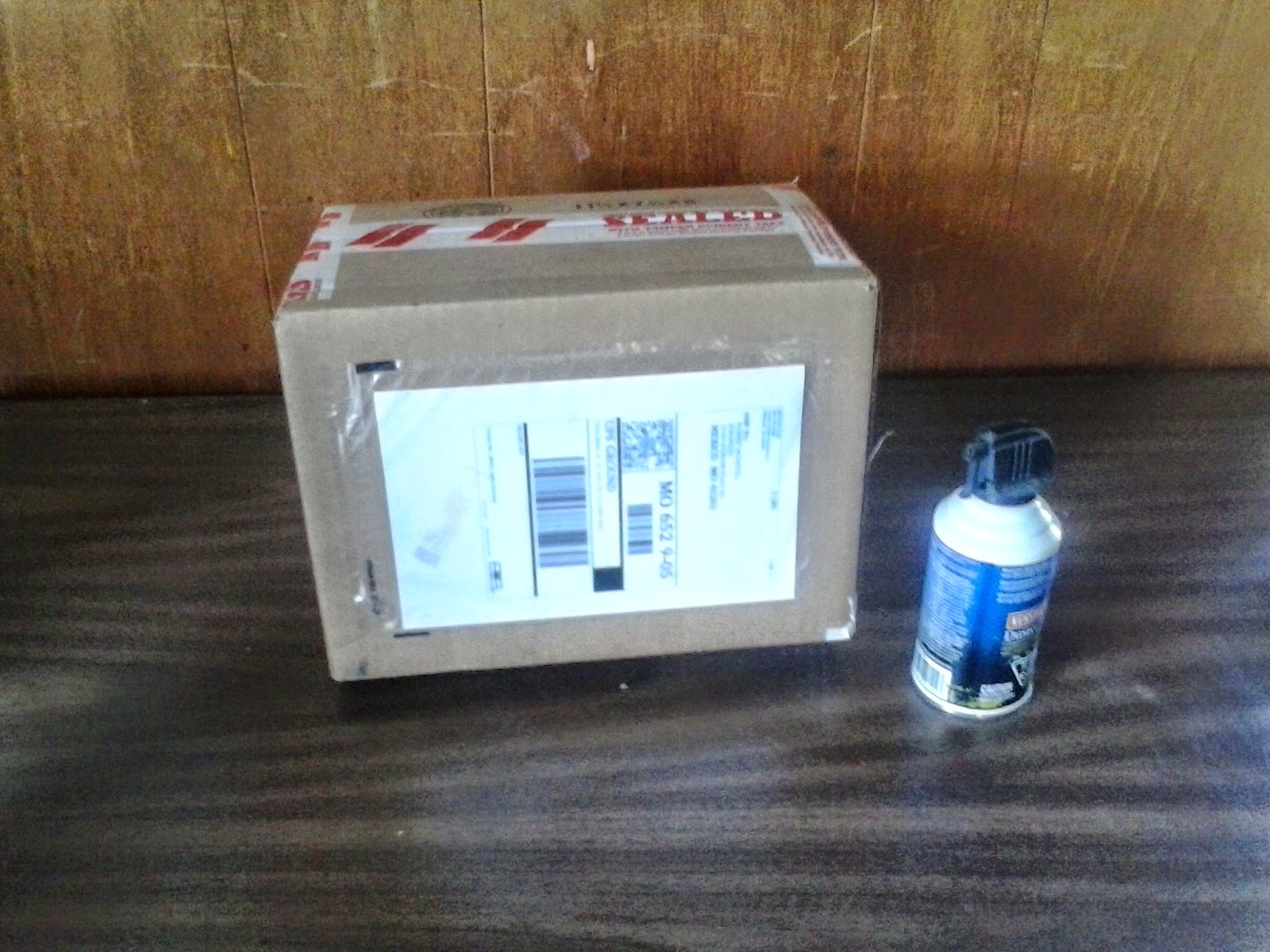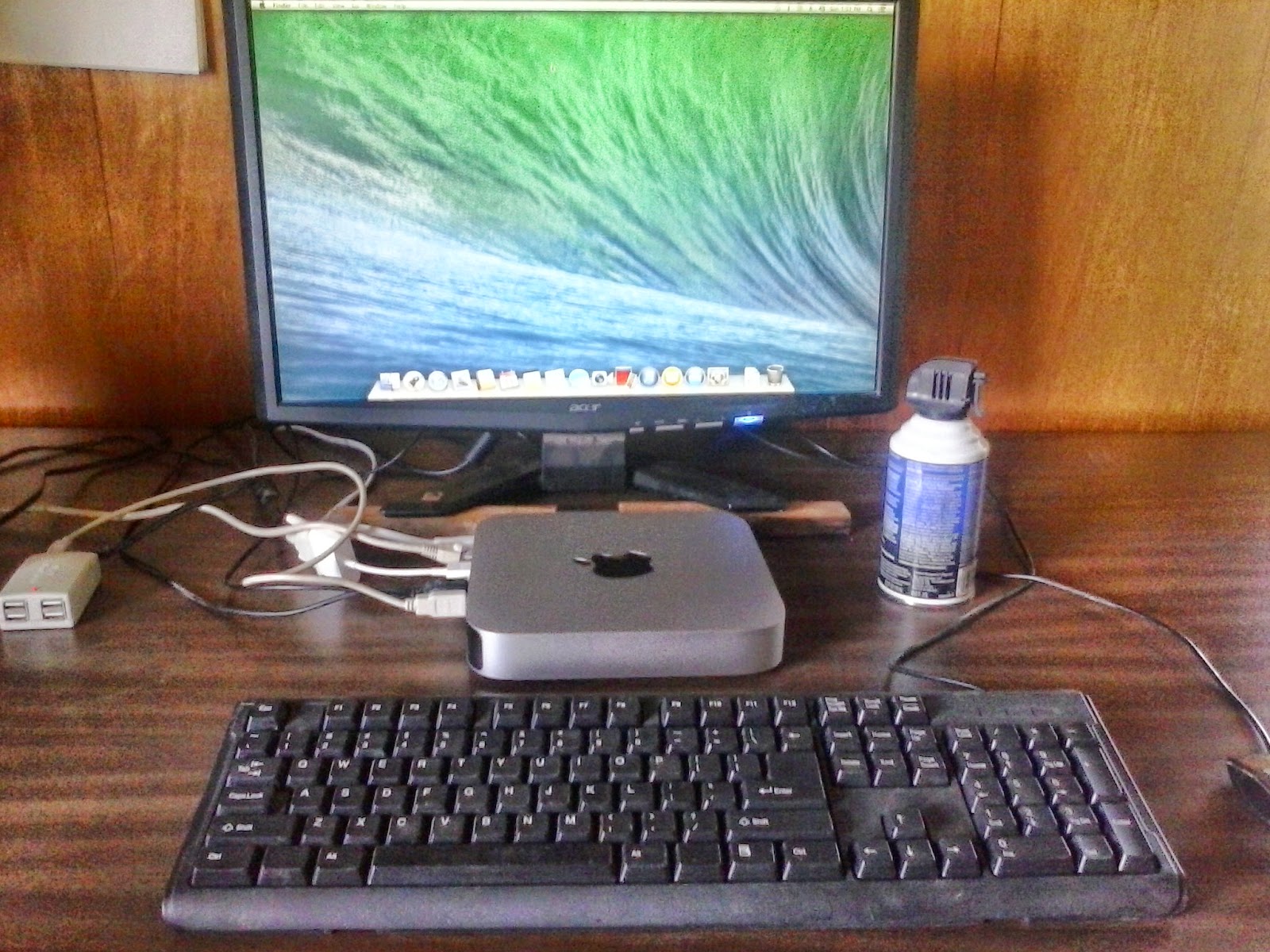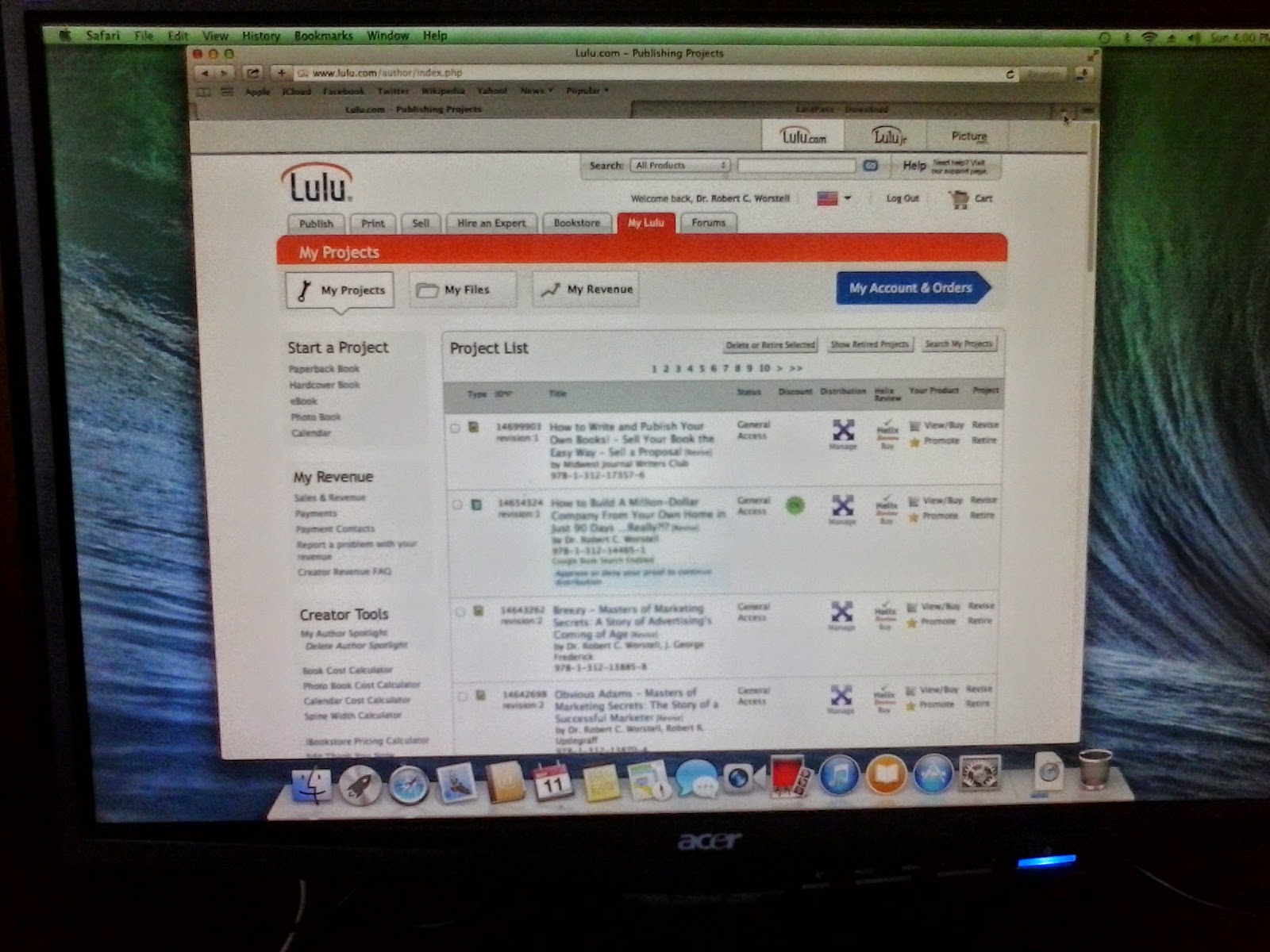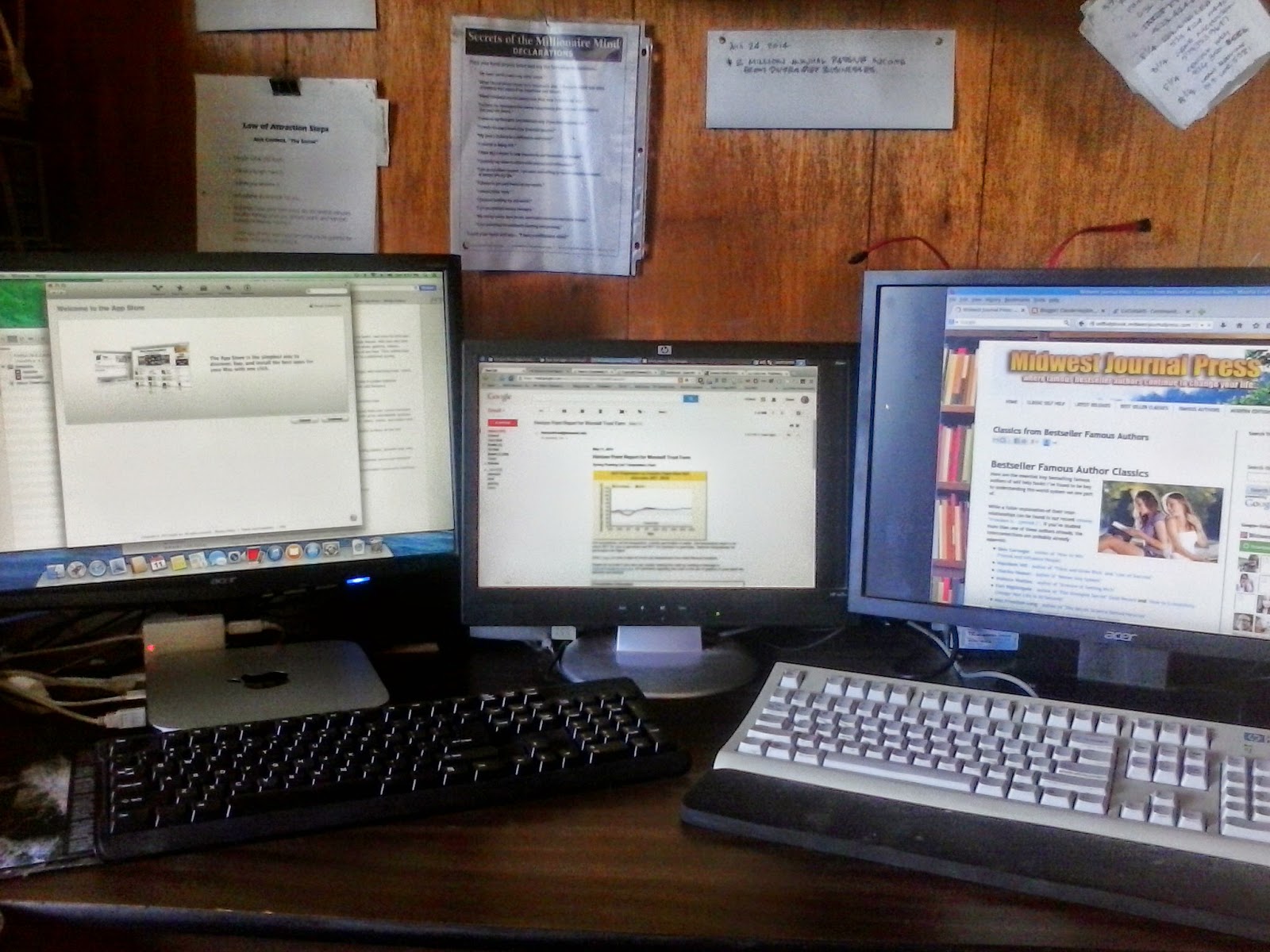Adventures in Apple-land: Using a MAC as a Self-Publishing Platform
When we last left our hero, he had made the decision – and leapt into the mist.
I ordered a MAC mini (hold the fries) and it arrived two days later. I celebrated by cleaning my desk and removing all the old hardware, cables and everything dusty.
We’ll do this in steps. First, the unboxing:
 |
| Nice box from Best Buy online. Gas Duster for reference. |
 |
| And look at all the stuff inside… |
 |
| All hooked up with leftover/spare everything. |
 |
| Proof that the Internet works – from the people who made my MAC necessary. |
 |
| My full set-up with the right two monitors going to my Linux box. |
I last used one of the old PowerMACs (15+ years ago) so the familiar startup sound took me back to younger days…
Back to business.
As I suspected, everything I’ve needed to publish on Windows or Linux are available for MAC. So far, anyway. I’m in the middle of downloading programs like LibreOffice, Firefox, Calibre, Sigil to see if this is all available. I’ve got nothing against Safari, it’s just that I’m not used to it. But yes, MAC versions are available for all of these, and the Writer2Epub plug-in works as well.(See below for links and download sizes.)
The idea here is that a non-MAC user should be able to shift platforms (like how I ditched Windows for Linux.) I’d worked out a production flow which had creation in LibreOffice, and side-checking with Sigil, meta-data stored in Calibre. Firefox has always been my browser of choice (IE has always had security issues, and Chromium is fine, but not the same.)
So if a person has that production flow in Windows or Linux, they can do it on the MAC, too.
Next, in order to publish on iTunes, you have to have an Apple ID, which is fairly easy to set up, and then download iTunes Producer.
Since we are straining my “poor” overworked Internet provider, we’ll let that run and get some sleep tonight.
– – – –
After coffee and breakfast: Well, the download didn’t. Turns out Safari doesn’t handle resuming downloads simply (takes a command line trick.) So I restarted that Firefox download and will install “downthemall” plug-in to make this happen. (With that download manager, you can restart paused/incomplete downloads.)
Again, just making it so I can use the tools I’m familiar with to get to work on this platform.
The blow-by-blow continues…
Since this is a 56mg download and my provider is currently penalizing me at their end of their month, I’m going out to do my chores now, and come back to finish this (hopefully.)
Update: The MAC has pre-configured SAMBA filesharing – nicer than out-of-the-box Linux, actually. OK. Funny enough, the common denominator is reverse-engineered Windows network sharing. Will need some more time on this to figure it out completely. Some work on this (while waiting for my downloads) showed that logging in as a remote user was easiest to get access – but is not work-safe for kids or “hacker wannabe’s”.
I’ve taken all my current files and sending them over via the network, so I can test the entire workflow. Calibre and GIMP need something to do.
(Oops – this download didn’t go. Too much too fast for my poor Internet Provider, who says I’ve already downloaded too much, until next month’s allotment, which starts in a few days.)
Meanwhile, I finally got the downloads down and, well – see below…
– – – –
What you’ll need to simply get started creating your ebooks just like you did on Windows or Linux:
The iTunesProducer file is a 305mg download. Firefox is 59mg, Calibre is 84mg, Sigil 34mg, LibreOffice 190mg, and writer2epub is 1.4mg. So you may be at this awhile to get what you need. Oh – and don’t forget GIMP (95mg) for doing your covers.
This means a person can easily shift to the MAC. What the MAC mini does is to make it relatively inexpensive. Anyone who has dealt with older machines usually has leftover mice and keyboards and monitors around. (USB and HDMI video – not the older plug-in versions – although I have a VGA adaptor coming…)
[Update: The Sigil initial download wasn’t accepted by the MAC – until I Googled the phrase and found this solution. With that window open (security preferences) it will allow you to install the dmg package that just failed, one at a time. (No need to permanently set yourself wide open.)]
[Update 2: Hold down the control key when you click open, and you get the same “Are You Sure?” dialog.]
[Update 3: While this could be a separate post, all you really need to post your book to the MAC is to download and install their free iTunes Producer. You manage your books in iTunes Connect (http://itunesconnect.apple.com) via most any web browser. If you are already editing it on your Linux/Windows platform, you don’t have to download a bunch of stuff to get going. I use Dropbox to sync my latest version to my MAC, and then simply upload those files in the next batch I have going. I then edit or improve the meta-data through my web browser. Again, the added value of a MAC is in the A/V you’re now able to create for marketing your book.]
That means we have all the tools we need to create and edit.
However, until I solve file transfer, I will be using the workflow described below. By getting all the vital tools over to the MAC, it says that a first-time self-publisher could easily use a MAC to get their books up and going. And anyone dissatisfied with Windows could make the jump to a better platform. If you need elegance, that would be the only reason to move to a MAC from Linux, IMHO. But I’m a geek down deep and have always loved to get below the hood and tinker. My MAC mini will be a very capable back-up for my dual-monitor production machine.
As I said, when I solve the file transfer (SAMBA) scene, then this may change.
Whoring the MAC to get to iTunes.
The basic summary is that I’ll be “whoring” this platform, using it mainly as a “go-to girl” for uploading to the various distributors – but chiefly, this MAC will be used for uploading to iTunes and handling audio recording. Reason being that file transfer is buggy at best – until that is solved, there is no real way to get files across except “sneaker-net” with flash-drives.
One additional feature is the native ability to simply create podcasts. Yes, you can do this with either Windows or Linux, but having a second machine should make this much easier – as I don’t have to move/unplug the mic. Yes, I can get good old Audacity for MAC as well. Podcasts and videos are the necessary content production needed for marketing.
This MAC didn’t come with any iMovie (it’s a $15 app) so it also doesn’t qualify (right out of the box, anyway) to handle making audio into video. My Linux version actually came with several of these programs – again, I have those 15 years which was more Linux than Windows during that time. So creating videos is still a learning scene.
[Update: I’ve found most of these Linux NLE’s (movie editors) are also ported to MAC OSX, so that’s an upcoming adventure.]
Plus, my Linux box has dual monitors, which is a simpler work flow.
I’ll get there with the MAC, but essentially it’s the learning curve which is throwing rain on this parade. (Coming up on Day 3 where I should have been editing and publishing.)
The bottom line is: Yes, you can do everything I do to self-publish a book on all the various distributors on a MAC. But just because you have to publish to one distributor, doesn’t mean you’re going to have to publish everything from there. It’s possible, though.
All these downloads will make my learning curve on this platform simpler and shorter.
An alternative work-flow
Go the Leanpub route to build your book. This gives you a tested version at the end, which should pass muster. Means you
- Get a MAC (mini) and set it up with all these programs.
- Edit your book into shape with LibreOffice, but save it as an HTML file.
- Next, you open that in Leanpub and tweak it online.
- As part of that, create the cover in GIMP.
- Then, when you are happy with it, publish, then download their generated epub, mobi, and PDF files.
- Right after that, test it on Lulu to be sure (and to get your free ISBN.)
- If no go,
sneaker-net it over to another box totweak it on Sigil until it passes(or fire up a virtual machine and do it there.) - Then upload to iTunes and everywhere else, saving your metadata to Calibre so it’s a copy/paste production.
Now you can do it all on a MAC. See, that wasn’t so hard, was it?
If I were just starting out, this is the route I’d take, since that single investment in a MAC mini would pay for itself in short order.
Additional marketing goodies
The MAC started out as a desktop publishing wonder, but then quickly got adopted by the A/V crowd and never looked back. As an addition to my other workflow, this new MAC will be able to do my podcasts and video production to be able to reach a wider audience with my book projects. With LibreOffice being able to export PDF’s with embedded links (Leanpub’s capability for your finished book) you then have all the major formats anyone could want to find about your book – and also, to create packages of goods anyone could want. (And also do something like Tim Ferris’ bittorrent marketing)
For me, I’ll have a standalone solution to audio and video in addition to my book publishing. So this investment – which pays for itself in the fees I don’t have to pay to any aggregator to just reach iTunes – gives me auxiliary bonuses. Before this, the mic would have to be unplugged and moved away and back when I wanted to record, which left it less than useful – and less prone for me to actually do the recording. (Not to mention that the MAC mini has no machine noise, so if I ever build a sound booth, it will fit in perfectly.)
Not bad for a bunch of leftover peripherals and a $600 box.
Hardware wars – over?
I used to mess with building and re-building machines in the old days, accepting any amount of used equipment people would throw my way. What I found was that it was burning my time with little results. Re-cobbling parts together would as often as not result in no working machine, even when I put the original one back together “just like it was.”
The real scene is that producers have moved to new formats of RAM and connectors which have made the other machines too expensive to upgrade. With few exceptions, such as installing the maximal RAM you can when you buy a machine – key on Linux (Windows often won’t see or be able to use the extra) – there’s little additional to do.
With the MAC mini, you can go to top of the line for about twice as much, which will give you 16gigs of RAM and a monster CPU – but the question for a struggling publisher is the cost benefit.
$600 is just above what I’d consider a decent price range for a new box. Sure, I can get a machine with the same specs as this MAC Mini from Overstock or similar for maybe $300, also with no monitor (but giving me yet another keyboard and mouse) – but it wouldn’t get me into iTunes. Sure, I could spend the time getting torrents downloaded of a MAC disk image which would run on a virtual machine inside my Linux box – but that’s for the uber-geek.
Time invested needs to leverage into income. For the average author, getting a MAC mini as a replacement computer is quite a leap, but can result in doing everything you need. The extra $200 also means a week or so that I don’t have to spend getting a machine up and running on Linux – and just as stable.
Note: In my mind, there is no reason to use Windows, if you haven’t guessed this by now. Part of the upgrade was giving away my last two Windows-only machines, which were on obsolete hardware. No way to go back. (I do have XP running on a virtual machine, for a minority few programs which were only ever released to Windows platform. It’s still amazing that each Windows machine has to have it’s own anti-virus and firewall program,when Linux and MAC natively don’t.)
[Update: I was annoyed by the lack of keyboard shortcuts. So I got a bluetooth keyboard which 1) didn’t have the same look and feel – it slowed me down with errors, and 2) quit working once the original batteries went on the blink. So I plugged back in my old USB keybord (with those satisfying pushing keys/clicks) and found I could remap the “alt” key to do the same as the “command” key in Windows. As there are very few shortcuts which actually use the alt key on a MAC, it really solves the problem. (Chief short-cut I use is alt-tab – from Windows days – to shift between applications.) Situation solved – other than it takes another USB outlet.]
[Update 2: I’ve found that a lot of hardware which would only work with Windows (not on my Linux box) has been ported to MAC, so drivers are available. One scanner I thought was only available on XP was able to get going under a MAC, courtesy of the companies updated drivers.]
Batch production
My current plans are to do the development of batches of books, then copy sets of epubs with the final-final versions and their covers over to a jump-drive for transfer. This looks to be the simplest, most direct, and most efficient production line. This makes iTunes the last on the block, maybe excepting Leanpub. (Even Amazon and Smashwords accepts epubs, so this is again the lowest common denominator approach.)
Out of the dozens of books I’ve published to date (OK, it’s over a dozen dozen at this point) the public domain and PLR books sell the best. So setting up batches of these (or saving up collections until I have a batch) is simpler than some indie author writing original fiction. For that person, the best approach is to fire them out when the editing and proofing is done – and then get busy writing the next one.
Writers get paid by selling books, not by worrying over whether they are selling. “Writing feeds the soul; Publishing feeds, clothes, and houses the body – plus pays for the occasional night out on the town.” It’s the backbench of books which proves that theory.
– – – –
While this last section really requires a new blog post, a short analysis today (while waiting for downloads, etc.) showed me that this is the core of my little one-man-band of a publishing company. I have a few large batches worked up for the near future, and then I’ll be ready to move over to a quasi-original derivative set of hand-illustrated classic stories.
Right now, I’m learning from classic copywriters. Once I’m content with a sufficiently deep back-bench, then I’ll move over to marketing what I’ve been creating and meanwhile doing a segue over to these illustrated children’s fables.
Lulu just compounded my work-flow by forcing me to get a MAC in order to do what used to be their job.
What this will eventually do is to improve my marketing backend, as I can do a lot more A/V work with this set-up.
Now you’ve had another glimpse into the world of an avid self-publisher.
Yes, there’s a book in your future – part of which you’re reading now. Someone has to tell the story of how anyone in the middle of nowhere can create a “publishing empire” from little more than consistent, focused production over a few years time.
Stay tuned…






